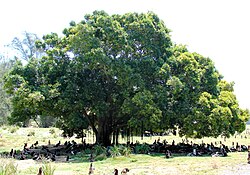Shade tree

A shade tree is a large tree whose primary role is to provide shade in the surrounding environment due to its spreading
urban parks and house yards
, and thus, also protecting them from the sun's harmful UV rays.

Some of the most popular shade trees in
African tulip tree species are often planted as shade trees.[2]
Specialitys
These trees are commonly grown, and/or used, as shade trees due to their protuberant size:[3][4][5]
Paperbark
trees have a large canopy, supplying adequate shade.


- American elm
- American sycamore
- Austrian oak
- Brush box
- Banyan tree
- Black walnut
- Blue Jacaranda
- Camphor laurel
- Cape Chestnut
- Carob tree
- Chinese elm
- Coastal Coral Tree
- European beech
- Honey locust
- Golden Ash
- Golden rain tree
- Holm oak
- Hopea odorata
- Hill's weeping fig
- Indian horse-chestnut
- Japanese elm
- London plane
- Moreton bay fig
- Norway maple
- Oriental plane
- Palestine oak
- Pepper tree
- Port Jackson Fig
- Red maple
- Royal poinciana
- Rough-barked apple
- Scarlet oak
- Scholar tree
- Silver linden
- Shumard oak
- Small-leaved fig
- Southern live oak
- Swamp Spanish oak
- Sweet gum
- Sycamore fig
- Sycamore maple
- Sydney red gum
- Tulipwood
- White feather honeymyrtle
- Yellow box
Planting
There are a few factors to consider when choosing a shade tree:
back yard, by obstructing the view of outsiders. A disadvantage is that in cool climates, an abundance of shade trees may lead to a dank environment in any nearby buildings or gardens. Shade trees must not be planted near chimneys as flying fire sparks can ignite tree branches which could cause rapidly expanding fires.[4]
Planting shade trees around a home can also reduce the energy that homeowners use in the summer months. Planting shade trees in locations near a home air conditioner can keep the air conditioner cooler which helps it run more efficiently, so less energy is used.[6]
See also
References
- ^ Shade Tree
- ^ AgroForestryTree Database - Species information Archived 2013-01-13 at archive.today
- ^ Winterhill Tree Farm - Shade Trees
- ^ a b ABC - Gardening Australia - Shade Trees
- ^ Selecting Landscape Plants: Shade Trees by Diane Relf, Extension Specialist, Horticulture, Bonnie Appleton, Extension Specialist, Horticulture, Virginia Tech
- ^ "How to Plant Trees to Conserve Energy for Summer Shade - Climate Change at arborday.org". www.arborday.org. Retrieved 2017-05-03.
